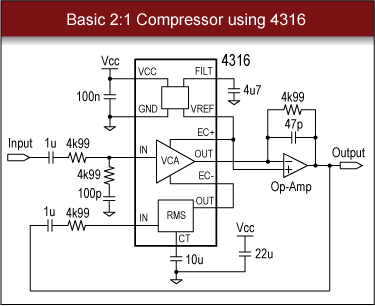I want to compliment you vmsa on your three excellent threads. "Logithmicizing" the LM3914 is brilliant and I follow with great interest the QRMS and K-filter.
I thought I would offer a suggestion for RMS detection using a THAT Design Brief sent to me by Roslafonso Bortoni not yet published which is similar to the original DN-119 "Wide Ranging dB Meter." The Design Brief suggests using a THAT4305 but since you're interested in a 5V solution the 5V THAT4316 could be used. A single 4316, along with an outboard level-shifting op amp, would provide all three functions of the QRMS and solve LM3914 "logification." The circuit below performs (1) Absolute value, (2) RMS and (3) linear dB scaling. It could also provide a large dynamic range probably more than you would actually need. Rosalfonso simulated the circuit and I built it for him using a 4315 and it easily, at 1 kHz, had a 100 dB DR. Though all of that DR may seem to be overkill and doesn't have to be used you can't beat the circuit for simplicity, low cost and 5V operation.
Here is the 4305 version. I did discover that to be equal to a THAT2252 Ct (C3) needs to be doubled to 22µF. The circuit is pretty self-explanatory if you've read DN-119 or see it as a 2:1 compressor. R5's purpose is not obvious and is critical to circuit operation as it provides a load for the VCA's internal output current mirror. On the 4316 the VCA and RMS outputs are biased to 2.5V and it would appear R5 would need to tie to the +2.5V bias pin.
View attachment 116424
You could also use this circuit as a guide and take output from the RMS detector. The I-V op amp might be replaceable with a resistor as shown above.





